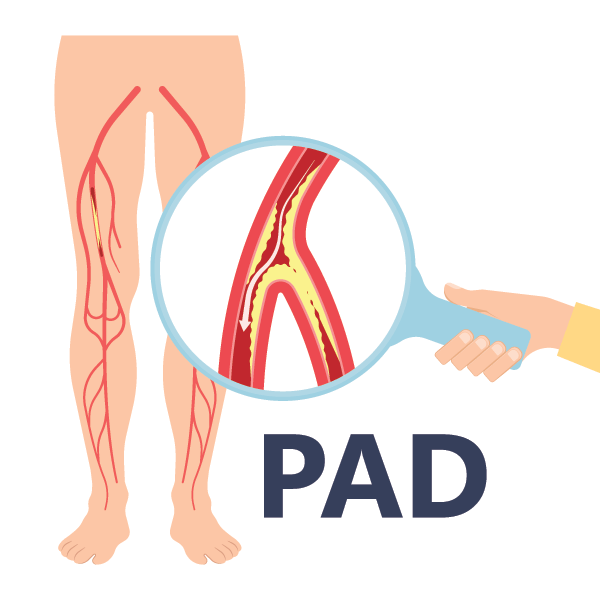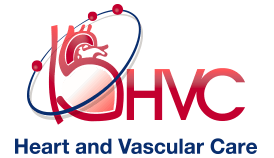Arterial Disease

A specific form of atherosclerosis, peripheral artery disease (PAD), affects the extremities of your body: legs, stomach, arms, and head. It most commonly manifests itself in the legs, though, as the arteries that feed the legs get narrowed or blocked by a buildup of plaque over time. Certain family histories or personal behaviors lend themselves to the development of PAD.
PAD Candidates
Those who need to be on the lookout for possibly developing PAD include:
- People over 70 years of age.
- People under 70 who are diabetic, obese, suffer from high blood pressure, and smoking or any other tobacco use.
If you fall within one of these age groups and qualifying factors, you need to be looking for PAD symptoms, which can be tricky to figure out as people sometimes mistake them for other ailments.
PAD Symptoms
PAD can manifest itself in a variety of ways. Most often the symptoms are related to the lower extremities.- Pain A blockage caused by a blood clot or plaque build-up in an artery may cause leg, hip, or calf pain while walking or climbing stairs. Often this pain will dissipate after resting for a few minutes. The location of the pain may give away the location of the clot as the blockage generally dictates the location from which the pain emanates. If you have a severe blockage, you may experience pain even while resting.
- Numbness or weakness Another symptom could be that the leg with the blockage is weaker or feels numb compared to the other leg. Stumbling or tripping may be the result of this symptom.
- Cold foot or leg You or someone else may notice that one foot or the lower leg is generally cooler to the touch than the other foot or leg. This difference in temperature indicates a blockage; the blockage in the artery is inhibiting the flow of blood which helps regulate the temperature.
- Lack of healing If you have a sore on one leg or foot that refuses to heal, that could be a sign of a blockage that is inhibiting the flow of blood necessary for the healing process.
- Different colors With less blood getting to one leg, the color of both legs may not be identical.
- Thinning hair As the blood flow is constricted, hair won’t grow as well on the appendage.
- Slower nail growth Just as the hair growth slows down and thins out due to the restricted blood flow, the nails do the same thing. Generally, nails grow at the same rate. If you begin to notice a difference, this could be evidence of a blockage.
- Weak pulse If one leg or one arm has a weaker pulse than its opposing limb, you could be suffering from a blockage.
Non-invasive PAD Treatments
Once PAD is diagnosed, your doctor will give you the best treatment option based on how severe the PAD is.- Exercise Often, PAD can be treated successfully through exercise. The process is called cardiac rehabilitation and involves walking, leg exercises, and time on the treadmill. If the PAD is severe enough, your doctor may require you to do this at a rehabilitation center where supervisory help is available if needed.
- Diet Your doctor may combine diet with your exercise to help control fatty, cholesterol buildup by moving you to a low-saturated fat, low-trans fat diet. If the diet isn’t sufficient, your doctor may also add a cholesterol-lowering medication to the mix.
- Smoking If you smoke or use smokeless tobacco, one of the best ways to treat your PAD is to quit completely.
- Medication Blood pressure medication, cholesterol medication, and anti-clotting medication are all possibilities if diet and exercise aren’t sufficient.
- Diabetes If you suffer from diabetes, your doctor will probably help you come up with a plan to help effectively manage your diabetes and minimize its contributing effects to PAD.
Invasive treatments
Although atherosclerosis seems complicated, with the right professional walking you through it, it doesn’t have to be.- Angioplasty Your doctor inserts a catheter into the vein and inserts a balloon into the catheter. The balloon is then inflated in the blocked artery, unclogging it. If necessary, a stent may be placed in the artery to keep the clog open.
- Atherectomy This procedure inserts a small device through the catheter into the vein. The device is then used to remove plaque from the artery.
- Stent After angioplasty, if there is still blockage present a flexible metallic stent is placed in the artery.
- Surgery The most invasive of the treatments, this is only used if an angioplasty and stents are not possible. Your doctor may choose to do a vein bypass, taking a vein from a different part of your leg and routing the flow of blood around the clogged vein.
